Predicting any market behavior is a guessing game. No matter how much data you accumulate, how many experts you consult, or how much ad time you buy, humans are only predictable to a certain point. The same goes with gaming. While there are certain trends you can watch for, such as a demand for legacy-style games or a downturn in a love for colonization themes, no one has the perspicacity to guarantee with absolute certainty exactly which games are going to become market hits and which are going to be forgotten as quickly as they’re released.
It’s not a matter of quality – plenty of worthwhile games go overlooked while mediocre ones become super popular. Nor is it one of familiarity – otherwise crowdfunding would largely be without merit. We can all make predictions on what we collectively think which games are going to resonate with the community writ large, but at the end of the day, it’s still just an educated guess.
Obviously there are a number of factors that, when analysed, coalesce into some safer predictions as to which games are going to be a decent seller or will generate industry buzz, but even those aren’t guaranteed. These games are better known as the New Hotness, the most hyped and sought after titles, and in our previous segment we looked at 15 games that had high degrees of interest and popularity going in and how they measured up to that initial fervor.
Today, we are going to look at a handful of the opposite: games that weren’t showing up in every single preview list and pre-convention conversation but whose positive reception in Indianapolis reached levels that equaled (and in some cases surpassed) many of the most hyped games at the onset.
So join us in Part 3 of our Gen Con 2018 Recap: Deluxe Edition, as we look at the 10 most surprising hits with attendees during the Best Four Days in Gaming.
Also See:
- Part 1 – Active Kickstarters
- Part 2 – The New Hotness
- Part 3 – The Surprise Hits
- Part 4 – News & Announcements
- Part 5 – What Comes Next
The Surprise Hits
Before There Were Stars
Publisher: Smirk & Laughter Games | Players: 3-6 | Play Time: 40-60 Minutes
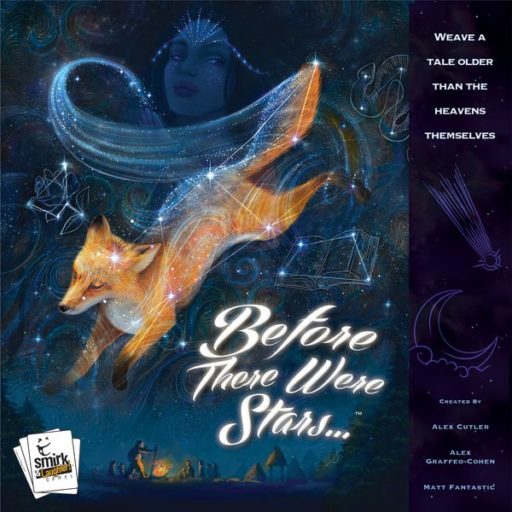 Some games are created to entice you with crunchy logic puzzles or aggressive tactical skirmishes. Then there are games that you don’t just play – you experience. Before There Were Stars is one such game. In this game, players become literal storytellers as they use constellation cards to forge various oral stories using the stars as their guide, from creation myths, to tales of great heroism, to parables for morality and understanding the world around us.
Some games are created to entice you with crunchy logic puzzles or aggressive tactical skirmishes. Then there are games that you don’t just play – you experience. Before There Were Stars is one such game. In this game, players become literal storytellers as they use constellation cards to forge various oral stories using the stars as their guide, from creation myths, to tales of great heroism, to parables for morality and understanding the world around us.
Bridging the divide in scope and cadence between a standard board game and a lightweight tabletop RPG like Fiasco, Before There Were Stars provides an open-ended and encouraging atmosphere towards creating your own stories, with points awarded less to your acumen as a storyteller and more to the creative and memorable moments within those efforts over the course of 45(ish) minutes.
The game’s largely open-for-interpretation nature of point allocation and narrative-driven focus isn’t going to appeal to everyone, but the reception at Gen Con was massively successful and quickly became a much lauded title by the end of the weekend. Part of this is undoubtedly because this style of game – short, easy to teach, and highly social – is ideal for a convention. But part of it is also the game’s emphasis on fostering an upbeat and positive gaming experience. Which makes perfect sense, as this precisely what Smirk & Dagger Games is trying to do with its new Smirk & Laughter Games imprint, with Before There Were Stars as one of the inaugural titles under that umbrella.
Its popularity is likely to be tempered once it reaches wider distribution in September, but it should nevertheless prove inviting to those who enjoy games that focus on creativity as strategy and an emphasis on the journey over the destination.
Everdell
Publisher: Starling Games | Players: 1-4 | Play Time: 40-80 Minutes
 If you follow us regularly on social media, you may have already seen us gushing recently about how beautiful Everdell looks, and finally everyone at Gen Con who wanted to got to see that for themselves. Originally a Kickstarter via Starling Games (née Game Salute), Everdell is a well-produced and visually stunning worker placement-driven tableau game where players are anthropomorphic animals attempting to build up their new woodland city over the course of four seasons.
If you follow us regularly on social media, you may have already seen us gushing recently about how beautiful Everdell looks, and finally everyone at Gen Con who wanted to got to see that for themselves. Originally a Kickstarter via Starling Games (née Game Salute), Everdell is a well-produced and visually stunning worker placement-driven tableau game where players are anthropomorphic animals attempting to build up their new woodland city over the course of four seasons.
Everdell has a lot of excellent table presence but avoids being another pretty game with no substance. Instead, the game positions itself well as a relatively accessible tableau-building resource management game, with enough decisions to feel meaningful but not overwhelming (think along the difficulty lines of Lords of Waterdeep, except with woodland critters and more synergy potential).
Everdell is a decent game, but we admittedly didn’t except to see so many people carrying around copies of it at Gen Con; it really did become one of the surprise hits at the show.
Not that we’re complaining.
If it sounds interesting to you, be it visually or mechanically, we do have one bit of sad news: if you weren’t a convention attendee or Kickstarter backer you’ll have to wait just a tad longer, as Everdell doesn’t officially debut until around October.
Monster Crunch! The Breakfast Battle Game
Publisher: Big G Creative | Players: 2-5 | Play Time: 20 Minutes
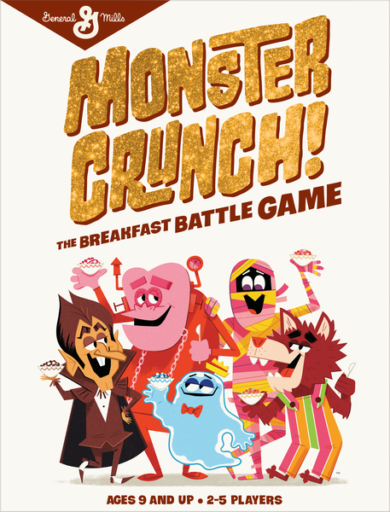 When it comes to general geekdom, never, ever underestimate the power of nostalgia. To some it has almost the same level of impact on their actions as the law of gravity and the primal need to eat. It’s that strong.
When it comes to general geekdom, never, ever underestimate the power of nostalgia. To some it has almost the same level of impact on their actions as the law of gravity and the primal need to eat. It’s that strong.
Which sort of explains one of the dark horse surprise hits of this year’s Gen Con with Big G’s Monster Crunch! game. Big G debuted four new titles this year, and just like its previous allotment, all of these will be arriving in Targets shortly (if they haven’t already). But Monster Crunch was easily the runaway hit of their lot, owing in large part to the theme of cereal box mascots from our collective childhoods duking it out over who can gobble up the most cereal.
Realistically, most people picked up Monster Crunch because of the nostalgia factor here, and less likely because they were seeking a 20 minute ladder climbing trick-taking card game, wherein you have to play a higher card than the player before you. Thematic disconnect with the mechanics aside, Monster Crunch is a sweet little game that plays quickly and adds its own couple of twists on ladder climbing games. It’s definitely on the less complicated spectrum among such titles (it’s no Tichu), but it’s also going to entice way more people to play this kind of game than trying to get a round of Clubs going.
Monster Crunch had little to no advanced notice prior to the convention, but many people found their way to picking up a copy anyhow upon hearing about it, if nothing else than for the novelty of it all. Objectively speaking, it’s unlikely to have as much staying power as some of the other titles on this list, but, again, when it comes to nostalgia, you never can quite be sure.
Pantone / Show & Tile
Publisher: Cryptozoic Entertainment / Jellybean Games | Players: 2-20 / 3-6 | Play Time: 15-30 Minutes
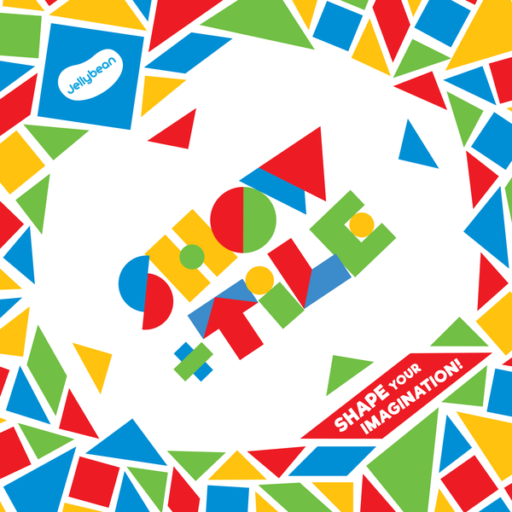
 Just when you think that a particular classic may start fading in relevance, along comes a new game that helps revitalize interest in by putting a new spin on the idea.
Just when you think that a particular classic may start fading in relevance, along comes a new game that helps revitalize interest in by putting a new spin on the idea.
When it comes to finding new ways of reinventing Pictionary (itself a reinvention of an even older game), this year’s Gen Con saw the debut of not one but two new releases that attempt to carve out new territory in the “guess what the other person is trying to convey to their team” space. And if that wasn’t news enough on its own, what is surprisingly noteworthy is that both titles sold particularly well, with Pantone having slightly more visibility due to Cryptozoic’s booth size and more centralized location.
In Pantone, one player is selecting and arranging a series of color swatches in order to get their colleagues to correctly guess a variety of historical and pop culture references. A series of successive clues on the back of each card provide some guidance for when people are stuck, but the more clues given, the less points the card is worth. Show & Tile by comparison is more of a race, with everyone getting a word and trying to get everyone else to correctly guess what it is by way of using tangram shapes.
Both titles make for some fast-paced and colorful party games, and many who enjoy this style of gameplay found themselves debating between which one to get, which ultimately comes down to a matter of gameplay style preference. Fear not though, as you still have a little time to decide: both games should be arriving within the next 2-4 weeks.
Piepmatz
Publisher: Lookout Games | Players: 2-4 | Play Time: 20-40 Minutes
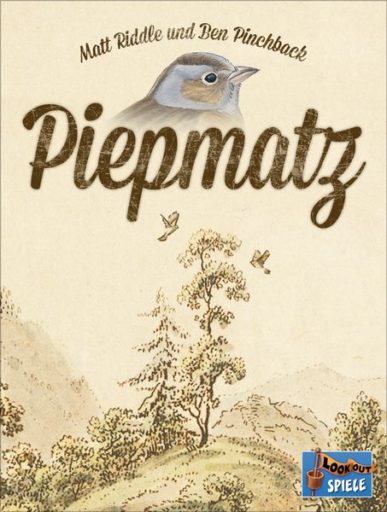 Piepmatz is sort of an odd mention on this list, because it may just be the least talked about surprise hit going. Despite it being designed by the solid design duo of Ben Pinchback and Matt Riddle, and despite it being released by Lookout Games – a traditionally go-to brand for many among the Euro gaming crowd – this is one title that could get easily lost among the post Gen Con shuffle. Which would be a shame.
Piepmatz is sort of an odd mention on this list, because it may just be the least talked about surprise hit going. Despite it being designed by the solid design duo of Ben Pinchback and Matt Riddle, and despite it being released by Lookout Games – a traditionally go-to brand for many among the Euro gaming crowd – this is one title that could get easily lost among the post Gen Con shuffle. Which would be a shame.
Similar in style and tone to the tree-placement game Arboretum, Piepmatz is a hand management and set collection card game about trying to accumulate seeds and birds at a bird feeder. (Stay with us here.) Over the course of playing and picking up cards, you are trying to ensure you have the right assortment of seeds and birds types to score the most points at the end of the game. This may sound a little dull flavor-wise, but Piepmatz is an excellent card game that’s easy to teach and has a casual pacing while sporting a cerebral quality where you’re trying to decide the timing of which cards to play for the best long-term payoff.
Piepmatz garnered a decent reception at the convention despite not having a ton of fanfare surrounding it, but that’s almost fitting. Unlike many other 30 minute games championed around Gen Con this year, Piepmatz stood out by, well, not being a high energy or highly social game. For a game about accumulating birds, Piepmatz is rather down to earth in its approach, with subdued artwork and a temperate theme. It’s the type of game that’s likely to fare much better once the lights and sounds of the convention die down, and so it says something about its merit that it still managed to get the level of word of mouth attention it did in such an environment. And what (albeit limited) copies they did have at the convention still flew away relatively early.
You won’t need to worry about this one migrating away before seeing it though, as Piepmatz is in the process of entering distribution right now.
Princess Jing
Publisher: Matagot | Players: 2 | Play Time: 15-30 Minutes
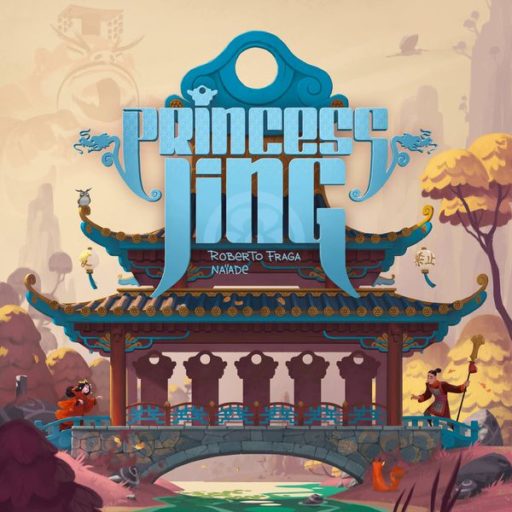 When it comes to producing games, there often is a calculated decision made somewhere along the line with regards to player size and price point. That is, for games that are designed for loads of people, or just two, publishers generally try to keep the cost of the game down in order to entice the largest number of people to said game. There are plenty of exceptions to this, of course, such as multi-hour war games aimed at two people and an occasional party game that fetches a higher cost than you’d originally expect, but most fall along this bell curve in some way for financial reasons.
When it comes to producing games, there often is a calculated decision made somewhere along the line with regards to player size and price point. That is, for games that are designed for loads of people, or just two, publishers generally try to keep the cost of the game down in order to entice the largest number of people to said game. There are plenty of exceptions to this, of course, such as multi-hour war games aimed at two people and an occasional party game that fetches a higher cost than you’d originally expect, but most fall along this bell curve in some way for financial reasons.
And then there is Princess Jing, one of the pricier games out there for a 25 minute two player game.
This isn’t isn’t to say Princess Jing is bad. Quite the opposite, in fact. The game has a stirring table presence and has piqued the interest of many since Matagot first showed it off at Gen Con last year. In this two player game of bluffing, deception and escape, both players are trying to guide their princess out of the castle without being caught by their guardians. Thus begins a cat-and-mouse game of trying to find your way through a series of hiding points while dodging your opponent’s traps. This is done through a unique combination of 3-D barriers and actual mirrors, making for both a tactile and picturesque experience. It’s part love story, part fun house escape, and part Stratego, except that each person only has one unit to worry about making it out alive. And it all works perfectly well as a lightweight test of skill between two people.
As a result, Princess Jing reinvigorated interest in the game at the convention with its finished version, and many people there took to it eagerly based on its look and gameplay. The larger question will be how well it fares in the larger gaming realm, as all of its quality components don’t come cheap: for a two-player only game that takes less than a half hour, Princess Jing comes with a $50 price tag. To invested hobbyist gamers that’s one thing; for a wider audience, that price may prove slightly prohibitive to becoming a runaway hit. We’ll ultimately find out when copies start entering circulation within the next couple months.
Railroad Ink
Publisher: CMON | Players: 1-6 | Play Time: 20-30 Minutes
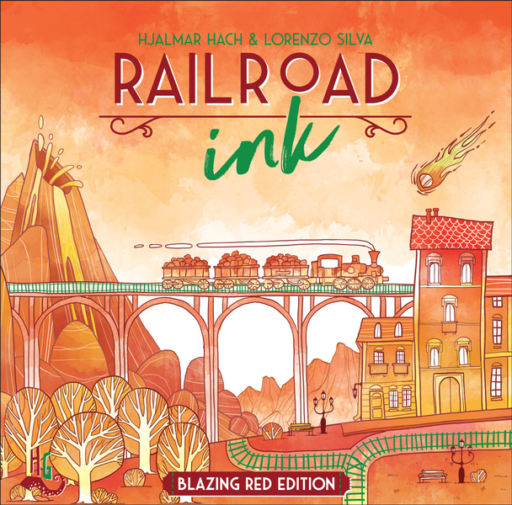 We’ve already mildly alluded to the popularity of Railroad Ink in the last segment, but it bears its own mention here. Railroad Ink is a small, quick, traditional roll-and-write game where players are trying to create railroad paths to create as many exits off your board as possible by selecting and using the dice in front of them. Think Karuba: the Dice Game. The more exits you can make, the more points you get. The person who can create the most optimized board after a couple rounds of dice rolling will go on to ride the train to Championsville. Or Victoryberg. Or…you get the idea.
We’ve already mildly alluded to the popularity of Railroad Ink in the last segment, but it bears its own mention here. Railroad Ink is a small, quick, traditional roll-and-write game where players are trying to create railroad paths to create as many exits off your board as possible by selecting and using the dice in front of them. Think Karuba: the Dice Game. The more exits you can make, the more points you get. The person who can create the most optimized board after a couple rounds of dice rolling will go on to ride the train to Championsville. Or Victoryberg. Or…you get the idea.
In addition to the dice themselves, each player also has a series of one-time use symbols that they can use instead if they feel that’s their better option, but once they’re used up, that’s it for the entire game.
The hook to Railroad Ink, aside from being a rail-based roll-and-write with a cheap price point, is that it comes in two versions: Red and Blue. Each version has a set of unique environmental dice that cause additional difficulties to your board. You know, like contending with lava, meteors, and rivers to navigate around.
Showing the current appeal of the roll-and-write genre (as well as it being the perfect sized game to carry around at a convention), Railroad Ink managed to leave an impressive mark on a lot of people, which is especially notable given the competition from similar titles at the convention and all the attention CMON was getting for its litany of other, larger titles in their release lineup. To a point that CMON ran out of both versions to sell quicker than even they anticipated. Unfortunately, if you weren’t able to grab one, the wait time to grab one here in the States likely isn’t until November.
Villainous
Publisher: Wonder Forge | Players: 2-6 | Play Time: 45-60 Minutes
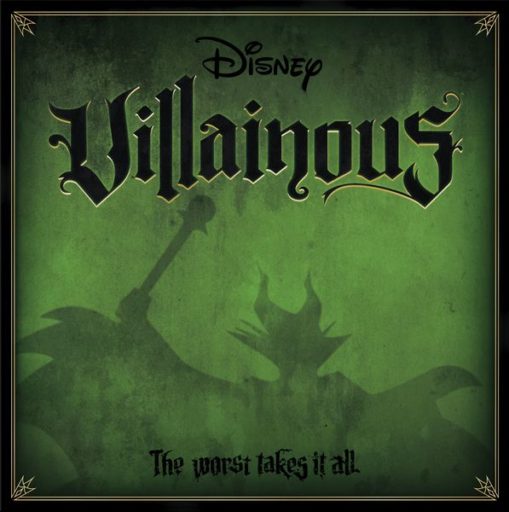 Apparently it’s good to be bad.
Apparently it’s good to be bad.
In this I-Shouldn’t-Be-Surprised-This-Was-So-Popular-But-Still-Kind-Of-Am situation, Villainous is a game where you play as various as Disney villains, all out to achieve your own ends. From Prince John, to Jafar, to Captain Hook, to Ursula, every player tries to be the first to succeed at their evil plans. Despite being a Disney game with recognizable characters, however, this isn’t quite as much of a mass-market game as it may first seem.
The game is a little more involved than it appears, as each player has their own secret goal and must take steps as they visit the different board locations to properly set up the circumstances around that goal. Some involve the quest for money, while others must get specific do-gooder-cards to specific locations. And since you’re the bad guys, some of your actions involve messing with the plans of one another.
It’s light enough that many first-time gamers can play it when they’re inevitably drawn to it by the Disney themes, but it’s far from a poorly-designed game simply made to cash in on the license. Which was, admittedly, my first thought when I heard about it a few months ago. I’m happy to report I was wrong. It’s an all-around decent game: playful but still substantive.
Villainous proved to be incredibly popular at Gen Con. Not only did Ravensburger (parent of Wonder Forge) have a tent running demos for this game the entire convention, but they were scheduling those demos out for the entirety of each day. So unless you happened to luck into being there when someone didn’t show up for their demo time, being able to sit down and actually play this one required showing up early each day to get your name on the board. Which is, frankly, impressive. The steady stream of players and curious onlookers, coupled with the power of Disney, caused Villainous to sell out much faster than its two other new titles, the Spiel recommended trail-building game Woodlands and the expansive legacy game The Rise of Queensdale.
If you’re like us and didn’t get in on the initial wave of interest, fear not: the game should be reaching widespread availability in a few weeks.
Warhammer Age of Sigmar: Champions Trading Card Game
Publisher: Games Workshop | Players: 2 | Play Time: 15-30 Minutes
 There’s one of them every year. Just when you think that CCGs as a model are finally dying off, along comes a new game that makes you sit up and wonder if it has what it takes to succeed in an ever-crowded games market whose consumers are more and more cautious, if not down right averse, to the very idea of them. Last year that was Steve Jackson showing off the surprisingly-fun (and now available) Munchkin CCG. This year, it’s Warhammer Champions, a Warhammer 40k themed CCG.
There’s one of them every year. Just when you think that CCGs as a model are finally dying off, along comes a new game that makes you sit up and wonder if it has what it takes to succeed in an ever-crowded games market whose consumers are more and more cautious, if not down right averse, to the very idea of them. Last year that was Steve Jackson showing off the surprisingly-fun (and now available) Munchkin CCG. This year, it’s Warhammer Champions, a Warhammer 40k themed CCG.
In this two player head-to-head style game, players must construct decks representing one of the game’s four factions. Each tailored deck revolves around four chosen champions, and your goal, as you’d expect, is to eliminate your opponent. Champions adds in the means of progressing by completing quests as well, but as with most tactical fighting games, the most expedient way to victory is through your opponent.
The most novel thing about this game though is it manages for your cards to exist both physically and digitally at the same time. You can use its app to scan the cards that you crack open into your online collection, duplicating your inventory in both places and avoiding the whole mess of having to decide whether you want to invest in the physical card game or its digital implementation (we’re looking at you, Magic). They are now yours in both places, allowing you to play with friends both in person and online. Scanning cards is quick, and to ensure its collectible nature, each card has a unique code embedded into its card frame that ensures it can only be scanned into the system once.
Warhammer Champions was certainly popular for a hot minute at Gen Con, and word about it got around despite not having much attention heading in. Whether it holds up in the long run is harder to gauge. For any given CCG (or even LCG) to succeed, it needs a critical mass of players in proximity to one another to keep it going, and nowadays that’s a huge uphill challenge for any newcomer. That Champions can co-exist in the digital realm is certainly an advantage to that end – as is it being part of Games Workshop’s popular Warhammer 40k IP – so it is possible the combination of those factors will help it avoid a similar fate as so many other collectible games, but only time will tell. It is still a CCG after all.
My question is when they roll out the opposite feature: where I buy digital packs and have them mail me physical copies…
Welcome To…
Publisher: Deep Water Games | Players: 1-100 | Play Time: 20-30 Minutes
 Welcome To is the second of two roll-and-write games on this list, proving two things (technically it’s a draw-and-write but it’s all the same family, really). First is that this plucky little genre of game – one that’s traditionally had a small but vocally supportive fanbase – is currently enjoying its modest time in the spotlight, and that likely isn’t abating anytime soon, evidenced by the fact that there were at least three other roll-and-write games shown off at Gen Con. The second is that the games at Gen Con most likely to generate buzz (and sales) while in attendance, despite not being one of the ‘big names’ coming in, are quick, accessible, replayable, and make excellent impulse purchases.
Welcome To is the second of two roll-and-write games on this list, proving two things (technically it’s a draw-and-write but it’s all the same family, really). First is that this plucky little genre of game – one that’s traditionally had a small but vocally supportive fanbase – is currently enjoying its modest time in the spotlight, and that likely isn’t abating anytime soon, evidenced by the fact that there were at least three other roll-and-write games shown off at Gen Con. The second is that the games at Gen Con most likely to generate buzz (and sales) while in attendance, despite not being one of the ‘big names’ coming in, are quick, accessible, replayable, and make excellent impulse purchases.
Welcome To certainly fits that bill.
Unlike several of the games on this list, Welcome To didn’t spring on the scene as a complete unknown. It has actually been slowly percolating in the board game sphere for a while now. It first appeared back in February, but attaining copies in the US was prohibitively expensive at first for most to even consider it. Conveniently, new publishing house Deep Water Games picked it up for North American distribution, and it debuted at Origins ahead of its official Gen Con release. So it’s had enough time around the water cooler to get on many people’s radar.
Those efforts clearly paid off. Not only were preorders for the game strong, but thanks to its low price point, small size, and ability to be played with groups large and small, it was easy for attendees to pick up and copy and play it that same day. A room-wide playthrough was even done during the annual Nerd Nighters event, helping its case further.
It should come as no surprise, then, that Welcome To quickly sold through its allottment, with demand far outpacing supply. It’s only likely to become more widely known as a whole new group of gamers start talking about and sharing their thoughts on this affable title, which is based around building suburbs in the 1950s. Your goal is to decide which amenities to add to which new houses in your new development, each of which are chosen from a rotating series of three face-up card stacks. Each amenity, such as pools, parks, fences, and so on, all score you points in different ways, and whoever has the most valuable suburb when the game ends is the winner.
Welcome To is officially available now, but as Deep Water sold out of their entire allotment, you’ll have to wait just a bit longer for the new print run to reach distribution before you can start showing off your architectural planning skills in earnest.
That’s all for now! Check back for the next segment when we talk about some of the notable upcoming games on the horizon that were being shown off at Gen Con.
